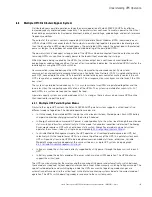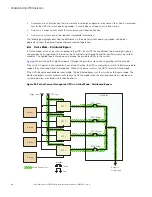
146
Eaton
®
Power Xpert
®
9395P-900 Installation and Operation Manual 164000501—Rev 12
•
A
command
is an intervention that is externally initiated by an operator or by some site action. A command
causes the UPSs to switch operating modes; it usually does not require any further action.
•
A
notice
is a minor system event that may or may not require attention.
•
An
alarm
is a system event that requires immediate intervention.
The following paragraphs describe the differences in the parallel system operating modes, using block
diagrams to show the power flow during each mode of operation.
66..44..22
O
Onnlliinnee M
Mooddee –– D
Diissttrriibbuutteedd B
Byyppaassss
In Online mode, utility AC power is supplied to the UPSs. Each UPS then conditions the incoming AC power
and provides clean, regulated AC power to the tie cabinet or distribution panel for parallel systems up to four
modules. The applied load is shared equally among the available UPMs in the system.
shows the path of electrical power through the parallel system when operating in Online mode.
If the utility AC power is interrupted or is out of specification, the UPSs automatically switch to Battery mode to
support the critical load without interruption. When utility power returns, the UPSs return to Online mode.
If the UPSs become overloaded or unavailable, the distributed bypass system switches to Bypass mode. The
distributed bypass system automatically returns to Online mode when the overload condition is cleared and
system operation is restored within specified limits.
Figure 85. Path of Current through the UPSs in Online Mode – Distributed Bypass
Tie Cabinet
UPS 1 Output
UPS 2 Output
UPS 4 Output
UPS 3 Output
Output to
Critical Load
Closed
Open
Breakers
UPS 4
Main Power Flow
Battery
Battery
Battery
Battery
UPS 3
UPS 2
UPS 1
UPS Input
Bypass Input
















































